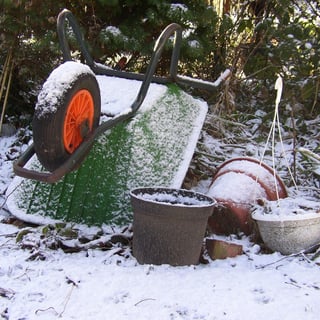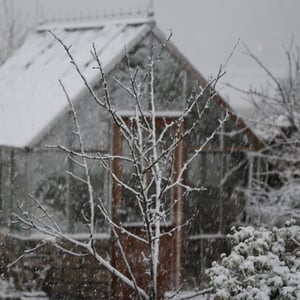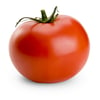What Can I Grow In the Greenhouse In Winter?
Written by Matt W (Greenhousestores) on 15th Feb 2019.

A greenhouse is an asset to any garden. Greenhouses extend the growing season, protect plants when they are their most fragile, and open up a wider range of options for the gardener. The best plants to grow in your greenhouse in the winter will depend on where you live, how big your greenhouse is, and your gardening goals. (For your own winter growing, take a look at our whole greenhouse range www.greenhousestores.co.uk)
What To Expect With A Winter Garden
The main thing to understand is that the plants will not grow as fast as they do in the summer. The days to maturity for each vegetable may double depending on the climate where you are. Some plants may not reach full maturity at all, yet will still be good to harvest. There will be some weeks where the plants don't make any progress, however, as long as they don't die, they will continue to grow as soon as the temperatures are high enough again. In December and January, in particular, there will be less growth or no growth at all. Don't panic! This is normal; just be patient and you will see them thrive again as soon as the days lengthen and the temperature rises.
Tools For Success
Greenhouse gardening in the winter is a very different experience than at any other time of year. In a cool climate, you need to plan very specifically what you grow and when you grow it. Generally, in January and February, there isn't a lot of light or heat available so you may need need to modify your greenhouse.
Keep The Heat In
Passive Solar
To keep the greenhouse warm without using electricity, passive solar plastic bottles are a great resource. Paint plastic bottles black and fill them with water. The black paint will make them absorb the heat of the sun during the day. At night, the stored energy is released automatically and heat up the greenhouse space. Place these around your aluminum or wooden greenhouse for best results.
Electric Heaters
Fan heaters circulate air as well as heat. They also have thermostats which are a great way to be more specific with the temperature. Many also have automatic thermostats that can be set to turn on only when the temperature drops below a specific degree. A set temperature around 2C is enough to keep frost away and keep most plants well.
Heat Pads
Electric heating pads are placed under near a container to keep the plant's roots warm. This is more localized than fans or other heating methods. Depending on your set-up, it can also be cost-prohibitive if you need a lot. The main benefit is the direct heat transfer and that they can be moved around easily. Seed-starting heat mats are good, however, regular heating pads for sore muscles work well too.
Insulate

Plants can be covered with fabric row covers to reduce heat loss and create a warmer environment. This is especially important for seedlings since they are more fragile.
Straw bales placed around the greenhouse can assist with keeping heat in. It doesn't add extra heat, however, reduces heat loss which can mean a lot for the survival of your vegetables.
That's right, regular packing bubble wrap makes a great insulator. It can be layered around the inside of the greenhouse walls and frame. It can also be wrapped around individual pots to keep roots warm.
Grow Lights
During the months when there is minimal sunlight, it may be necessary to add grow lights so the plants have enough. This will depend on the light requirements of what you are growing and the length of winter days where you are.
Choose Proper Seed Varieties
There are dozens of seed varieties for each type of vegetable. Look for ones that are cold-tolerant or have shorter growing seasons.
Plant in Pots
Plant seeds in the pots they will be staying in so there is no need for transplanting. Transplanting is stressful for plants and since they will already be dealing with the stress of cooler temperatures, it is best not to add more.
Plan, Plan, Plan!
If you have one greenhouse, then you will need to choose crops that have similar needs. It will be quite difficult to maintain different growing conditions in one enclosed space. Maintaining a uniform environment is less stressful and will give you greater success.
Winter Greenhouse Planting
Cabbage & Broccoli

These two cold season vegetables need a temperature between 45-55F at night and between 50-70 during the day. Warmer temperatures are actually detrimental to their growth. They are best started very early in the greenhouse, in mid-late winter, for a spring planting. They can also grow all winter long if the greenhouse is kept at the right temperatures.
Potatoes

Plant potatoes in large buckets or thick plastic grow sacks. If they are started in January, they will be ready to harvest in March. A crop started in February can stay in any Elite or Halls greenhouse to maturity as well. Or, if the climate is amenable, they can be moved outside and be ready to harvest at the end of April. Potatoes are susceptible to frost so if the weather is very cold, add some heat to your greenhouse or cover the plants to keep them warm.
Carrots

Plant them in the fall and they can be harvested as soon as the ground thaws. If you're having a good winter and the ground thaws once or twice before spring, check the carrots. They may be ready. The variety of carrot makes a huge difference here so make sure you get one that is very cold-hardy.
Lettuce and Greens

Lettuce and other greens are quick growing and prefer cooler temperatures. There are some that are resistant to frost, so check your seed catalog to get the best ones. Plant these in the greenhouse in the fall and don't transplant them. They will thrive in the greenhouse as the temperatures outside drop. Harvest the leaves as soon as they are big enough; don't wait for full maturity.
For the best results, plant a wide variety of lettuce and greens. They are a large amount to choose from and they have different maturity rates and temperature requirements.
Spinach

Plant successive sowings of cool-weather loving spinach and you will be harvesting almost all winter long. There are sometimes it may slow but it will bounce back once the temperatures rise again. It grows quickly when the temperature is right which makes it an ideal greenhouse vegetable.
Kale

The cold-hardy vegetable can survive temperatures down to -6C, depending on variety. When it gets colder than that, you will need to provide some heat for it to continue or wait until the outside temperatures rise and the plants start growing again. Plant several successive crops and you can easily have kale all-year round. Bonus: Kale grown in winter is sweeter because kale produces sugar to protect its' cells.
Garlic
In January, garlic can be planted and then transplanted in March or April or whenever the soil is able to be worked. They can also be kept in their pots and moved outside when the temperature is good. Make sure to choose a hard neck variety, as opposed to a soft neck, since hard necks are the cold-hardy type.
Herbs
Coriander, dill, leaf celery, and parsley are all cold-hardy and grow well in the greenhouse during winter. Start them in late-fall and have fresh herbs throughout the winter. Their growth will likely slow during especially cold and dark days, yet it will pick up again when the temperature warms and the days grow longer again.
Vegetables To Start In The Greenhouse
Tomatoes

Tomatoes are the number one vegetable grown in greenhouses. The growing season for tomatoes is generally long and starting the seeds in the greenhouse gives them a head start they will benefit from greatly. Tomato seeds should be started in the greenhouse 4-6 weeks before they can be transplanted outside. They need night temperatures to be consistently over 55F. Monitor the temperature inside your greenhouse to make sure it is warm enough for the tomato plants. They need lots of light which means the greenhouse needs to be in a place with full sun or there needs to be supplemental lighting.
Peppers

There are so many varieties of peppers, from bell peppers to all the hot varieties, and they all will do well in a greenhouse. They need night-time temperatures above 55F. Peppers can be started inside the greenhouse and then transplanted outdoors. Alternately, they can also be grown all season inside the greenhouse if the temperature is kept high enough.
Early Peas
Start peas in late winter and they will be ready for planting in early spring. This gives them a huge head start over peas that are planted outside when the ground can be worked. You'll be the toast of the neighbourhood with peas weeks before anyone else!
Cucumbers

Start cucumber seeds in your greenhouse in late winter/early spring. The timing should be planned so they are ready to be transplanted once the outside temperature is consistently above 70F.
Squash

Like cucumbers, squash benefits from being started in the greenhouse so that as soon as it is warm enough outside, they can be transplanted. Without this additional growing time, many squash varieties won't have enough time to come to maturity in short-season locations.
Okra
This vegetable plant needs around 2 months to mature. Okra needs a soil temperature of at least 65F. In many cooler climates, there is not time enough in the regular season to grow okra since it can't be planted outside until late spring. Giving the seeds an early start in the greenhouse will provide a huge advantage.
Aubergine

Start seeds in mid-January – February so they will be ready for transplanting in the Spring. Aubergine have a long growing season and in some climates, there isn't enough time to grow them at all unless they get a head start in the greenhouse.